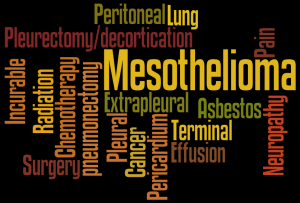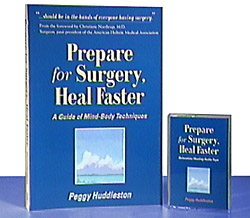Category: Featured News

Nurses and Author Team Up to Enhance Healing in Mesothelioma Patients
Mesothelioma patients often feel like they have lost control of their lives and health once they are diagnosed. On the contrary, according to one author who has dedicated her career to helping patients influence their own healing, patients have tremendous control over their cancer journey. They just need the skills to shift from feeling fear to feeling relaxed and peaceful.
Peggy Huddleston, psychotherapist and author of Prepare for Surgery, Heal Faster: A Guide of Mind-Body Techniques, received a Master of Theological Studies from Harvard Divinity School and has spent over 30 years researching the mind-body relationship. She ultimately developed a technique that harnesses “positive emotions and the human spirit” to speed healing.
“A person’s capacity for reducing pain is profound,” said Huddleston in an interview with MesotheliomaHelp. “When a patient learns to relax, he or she can significantly reduce both physical pain and emotional pain.”
Expert Insight
Peggy Huddleston
“I have a passion for seeing just how much patients can influence their own healing.”
Huddleston’s five-step process involves relaxation, visualization, asking friends and family to wrap them in a “Blanket of Love,” and healing statements spoken by the patient’s medical team. Huddleston says benefits to patients include less anxiety before surgery, less pain after surgery resulting in 25-50 percent less use of pain medication, and faster recovery.
Impressed Nurses Learn Huddleston’s Technique
While caring for a surgical patient, Lisa Hyde-Barrett, a mesothelioma nurse with more than 25 years of experience, realized there was something “special” about the woman. She was positive and relaxed, and her husband was equally calm. Impressed by her attitude, Lisa asked her how she did it. The woman said she purchased Huddleston’s book, Prepare for Surgery, Heal Faster, and then talked with her by phone for a personal, one hour workshop.
Intrigued by the patient’s outlook and recovery, Hyde-Barrett recruited co-worker Eleanor Ericson to join her at a two-day training offered by Huddleston that certifies medical professionals who want to use her techniques for patient care. The two nurses, who work at Brigham and Women’s Hospital in Boston and provide their expertise to the mesothelioma community through the “Nurse’s Corner” on MesotheliomaHelp.org, quickly saw the benefits of Huddleston’s techniques for mesothelioma patients.
“I have seen a lot during my career, and Peggy Huddleston’s method works,” says Hyde-Barrett.
“There are tons of research that says you need to have your head in the game before surgery- there is really no down side to this,” says Ericson.
The two are now both certified to offer Prepare for Surgery, Heal Faster workshops to patients and are working with Huddleston to bring the workshop to more hospitals in an effort to improve the patient experience.
Huddleston’s program is offered in leading hospitals throughout the United States including Brigham and Women’s Hospital, Dana-Farber Cancer Institute, NYU Langone Medical Center, Harvard Medical School and Kaiser Permanente Santa Clara Medical Center in California. It is also available at the University of Maryland Greenebaum Cancer Center, Carolinas Medical Center in Charlotte, NC and Norwalk Hospital in CT.
https://www.norwalkhospital.org/patient-and-visitors-info/integrative-medicine
Studies Show Patients Leave Hospital Sooner, Use Less Pain Medication, Have Higher Satisfaction
Huddleston points to various studies that show how, through enhancing the mind-body connection, patients heal faster and leave the hospital more quickly after surgery.
One study at the Lahey Clinic, a Tufts University Medical School teaching hospital, compared colorectal surgery patients who used the techniques in Prepare for Surgery, Heal Faster to a control group who did not use them. According to the study, the group following Huddleston’s program “had significantly less anxiety before surgery” and “were discharged from the hospital 1.6 days sooner than those in the control group.” The test group of patients also “used 60% less pain medication, had significantly less irritability, insomnia, nightmares, loss of appetite and had a significant increase in patient satisfaction” compared to the control group.
In a separate study, New England Baptist Hospital physicians found that knee-joint replacement patients using the Huddleston method were less anxious prior to surgery, healed faster and were discharged 1.3 days sooner than those not using it.
Once patients learn the techniques they can tap back into them each time they undergo another treatment, whether that is surgery, chemotherapy or radiation. In fact, further evidence shows the technique allows patients facing chemotherapy to lessen the side effects of anxiety, nausea and insomnia.
“If mesothelioma patients learn my techniques and put them into practice before their surgery or treatments, they could have a tremendous capacity to influence their own healing,” says Huddleston. “They can learn to access the deep inner peace that is their essence.”
Mind Over Matter Really Does Matter
Mind over matter practices have been around for a long time, and many medical professionals and Americans are beginning to be more open to holistic medicine that focuses on the mind-body connection. The stress of a chronic diagnosis suppresses the immune system when patients need the benefits of a healthy immune system the most. By calming the nerves and easing stress, patients can actually boost their immune system to help fight disease.
“People have such a capacity to influence the course of their treatment,” says Huddleston.
According to a recent survey from the National Center for Complementary and Integrative Health (NCCIH), the number of patients using alternatives to drugs and medicine, including yoga and meditation, to improve health and well-being is high. For example, the study found that between 2002 and 2012, the number of American adults who practice yoga nearly doubled to 21 million.
The NCCIH researchers believe the high rates of yoga use may be attributed to a growing body of research that shows the benefits of mind and body practices for managing pain and reducing stress.
“This is where medicine is going,” says Ericson, “treating the whole person.”
See the following for more information about Peggy Huddleston and Prepare for Surgery, Heal Faster:
- Boston Business Journal
http://www.bizjournals.com/boston/blog/health-care/2015/01/surgery-preparation-tool-sees-renewed-focus-as.html - HealFaster.com
http://www.healfaster.com/index.html
Know more about Mesothelioma and how you can deal with it.
Sources:
- Prepare for Surgery, Heal Faster: A Guide of Mind-Body Techniques
http://www.healfaster.com - National Center for Complementary and Integrative Health
https://nccih.nih.gov/news/press/02102015mb

Global Mesothelioma Rates Increasing in Many Countries, Italian Researchers Say
Mesothelioma incidence is on the rise in several nations, data show, but a lack of data for some of the world’s most populous countries, among other factors, obscures the true risk of asbestos exposure worldwide.
That’s the conclusion reached by Claudio Bianchi and Tommaso Bianchi of the Center for the Study of Environmental Cancer in Monfalcone, Italy in an article published in the Indian Journal of Occupational & Environmental Medicine. It is based on their analysis of data on mesothelioma incidence in Europe and Oceania as well as parts of Asia, the Middle East, and South America.
https://www.ncbi.nlm.nih.gov/pmc/articles/PMC2847331/
“The most recent data available on mesothelioma epidemiology show that in many counties the incidence of the tumor does not present signs of attenuation,” write the researchers.
Countries with high mesothelioma incidence rates include the United Kingdom, The Netherlands, Malta, Belgium, Australia, and New Zealand—countries that, with the exception of New Zealand, have banned asbestos.
Intermediate mesothelioma incidence rates were found in several European countries and the United States, where diagnoses peaked in 2005 at 3,284 but have since declined somewhat. Low incidence and mortality rates were reported for other European countries and parts of Asia, including Japan.
But as the researchers caution, a lack of data for a number of populous countries where asbestos is still not banned (e.g. Russia, China, Brazil, Indonesia, and India) calls the data’s reliability into question.
“On the basis of global asbestos consumption in the last decades, one may predict that a further mesothelioma wave will involve large geographic areas,” write the Italians. “These are exactly the same for which data are not at present available.”
The reliability of the data is also reduced by the difficulty of diagnosing mesothelioma and huge variations in incidence from one area of a country to another, something that the researchers say makes incidence rates at a national level misleading. Italian data from 1988-1997 show, for example, pleural cancer mortality rates that differ by 40 fold from one Province to another. According to the study authors, mesothelioma cases are typically clustered around asbestos-intensive industries such as factories and shipyards.
In Japan, however, a country heavily involved in shipbuilding throughout the 20th century, low mesothelioma incidence does not square with asbestos use history. The Bianchis theorize that this underestimation is attributable to “inadequate registration of the death causes” previously detected in Japan. Other countries with large 20th century shipbuilding industries but low mesothelioma incidences are Poland and Spain.
A final statistical factor to consider is mesothelioma incidence among age classes. The Bianchis cite a 2013 report on mesothelioma in the United States that found an annual mesothelioma incidence rate that increased with age. In the period 2003-2008 the incidence rate was 8.34 per 1,000 for the age class 65-74, 17.07 for the class 75-84, and 17.62 for the class 85+.
This reflects the long latency period of mesothelioma, which does not develop for 15-60 years following initial exposure to asbestos. It also reinforces the ideas that the phasing out of asbestos use may still be followed by a decades-long upward trend in asbestos disease incidence.
The full article, “Global mesothelioma epidemic: Trends and features,” can be read on the Indian Journal of Occupational & Environmental Medicine website.
https://www.fightmesofoundation.com/

Mesothelin Combined with a MiRNA May Be Effective Diagnostic Biomarker for Mesothelioma
German researchers have shown that a combination of protein and nucleic acid biomarkers improves the diagnostic performance of a blood-based screening test for mesothelioma compared to the use of an individual biomarker from a single molecular class.
Malignant mesothelioma, an aggressive asbestos-caused cancer with a long latency period of 40 or more years, has a low median survival rate of 9-13 months from diagnosis due to the fact that symptoms typically only occur during late stages of the disease. Diagnosis at early stages has the potential to improve therapy and survival, but the development of a reliable blood test has been hindered by the low diagnostic performance of most prominent biomarker to date for mesothelioma—mesothelin.
The biomarker mesothelin, according to the authors of a new study published online by PLUS ONE, is characterized by high specificity (89%) but low sensitivity (58%). That is, in patients with mesothelioma, blood tests that use mesothelin as a biomarker generate false positives 11% of the time and false negatives 42% of the time. The AUC (a measure of diagnostic accuracy) of mesothelin is 0.85.
By combining the protein biomarker mesothelin with the microRNA (miRNA) biomarker miR-103a-3p, the researchers improved the overall diagnostic performance of a blood-based biomarker for mesothelioma to an AUC of 0.93.
“In conclusion,” writer the authors, “we showed that the combination of mesothelin and miR-103a-3p improved the diagnostic performance of a blood-based screening test, resulting in higher sensitivity and specificity to detect malignant mesothelioma.”
Malignant mesothelioma is a form of cancer that occurs in the thin layer of tissue that surrounds the lungs, abdomen and heart. Asbestos exposure in the only proven cause of mesothelioma.
Up to 3,000 new cases of the disease are diagnosed in the United States each year, with 85,000 U.S. cases expected until 2054.
Anyone who was exposed to asbestos in the past—or who worked in occupations at risk for exposure—should be aware of mesothelioma symptoms, which include chest or abdominal pain, shortness of breath, and unusual lumps in affected areas.
Because early diagnosis is the key to a favorable prognosis, schedule a doctor visit immediately if you have symptoms that might indicate mesothelioma.
Know more about Mesothelioma and how you can deal with it.
Sources :
- biomarker
http://www.cancer.gov/dictionary?cdrid=45618 - (new study published online by) PLUS ONE
http://journals.plos.org/plosone/article?id=10.1371/journal.pone.0114483

Survivor of Royal Navy Vessel Sunk in WWII Succumbs to Mesothelioma
A former serviceman who survived the sinking of a battleship torpedoed by Germans in the Second World War recently died at his home in Berkshire, England of the asbestos-related disease mesothelioma.
Herbert Pocock was one of 1,200 crewmembers aboard the HMS Royal Oak in October 1939 when it was sunk by a German U-Boat in Scapa Flow, a harbor in the Orkney Islands, Scotland, that served as a deep water anchorage for Royal Navy ships during World War II. More than 800 men died in the nighttime attack.
One of fewer than 400 survivors of the sinking, Mr. Pocock, according to an article in the Scotsman, considered himself to be a very lucky man. But more than 75 years after he narrowly escaped with his life from the Royal Oak, it turns out that Pocock’s service to his country did, in the end, cost him his life, as a coroner ruled that his death was the result of asbestos.
https://www.scotsman.com/news/scapa-flow-torpedo-survivor-killed-by-asbestos-1-3610691
Coroner Peter Bedford found in his post-mortem examination of Pocock that the former Royal Navy engineer had malignant mesothelioma on his right lung as well as asbestos fibers in his tissue.
“As soon as I hear Royal Navy and engineer, that is a known link to asbestos,” Bedford told the Scotsman. “His exposure to asbestos is a result of his employment at some point in the past.”
Navy Veterans Diagnosed With Mesothelioma at a High Rate
Asbestos is the only known cause of mesothelioma, a cancer that’s rare in the general population but not among certain groups of workers, including Navy veterans. In fact, Military.com reports that veterans make up just 8% of the entire U.S. population but represent around one-third of all U.S. mesothelioma deaths. And among veterans, Navy veterans are the highest risk group for asbestos-related diseases.
The reason for this is that virtually all Navy ships commissioned between 1930 and 1980 contained asbestos-containing materials. In Navy vessel engine rooms and boiler rooms, asbestos was used on pumps, valves, boilers and turbines. Valves and pumps also had asbestos gaskets and packing.
If you worked aboard a Navy vessel with asbestos, particularly in the engine or boiler room, there is a very good chance that you inhaled asbestos fibers. Civilian shipyard workers who built and maintained Navy vessels may also have been exposed to asbestos. There is even a risk of exposure among the family members of Navy veterans and shipyard workers because asbestos fibers may have been carried home on clothing.
With a latency period of 15-60 years, mesothelioma is difficult to diagnose, especially because symptoms, such as chest pain and a persistent cough, can mimic those of less-severe respiratory ailments. Herbert Pocock, for example, in recent years suffered with fluid on his lungs—a symptom of mesothelioma—but a diagnosis was never made.
Contact an Experienced Mesothelioma Attorney
If you were diagnosed with mesothelioma, the law firm of Belluck & Fox, LLP, can help. We are a nationally-recognized New York law firm that represents Navy veterans and shipyard workers in cases against asbestos companies that failed to provide warning of their products’ dangers. We’ve obtained substantial compensation for those harmed by asbestos, including a $32 million verdict for a Navy veteran.
For help with your claim, contact Belluck & Fox, LLP, today for a free consultation.

Learn About Mesothelioma During Lung Cancer Awareness Month
For many people, November means apple cider, pumpkin pie, and Thanksgiving. In the health and medical fields, November is Lung Cancer Awareness Month, which emphasizes education and awareness of all things about lung cancer and other cancers affecting the respiratory system – such as mesothelioma.
The Ebola crisis that made headlines this October shows how easy it is to misunderstand or, worse, twist information about disease and health. Teaching the facts about mesothelioma, its symptoms, and its causes can help patients, family members, and friends better understand the disease and help advocate for the community.
Let’s Get the Facts Straight About Mesothelioma
In the spirit of Lung Cancer Awareness Month, here are some basic facts about mesothelioma that patients, family members, and friends can share with others.
- Mesothelioma is not contagious. No one can “catch” it.
- Some people that have mesothelioma blog about it and are okay if you ask them questions.
- The only known cause of mesothelioma is exposure to asbestos, a mineral with long, thin fibers that were inhaled or swallowed by people who worked around it. Other people who lived with those who worked with asbestos and carried fibers home on their clothing also breathed them in and can develop the cancer.
- More than one-third of U.S. mesothelioma patients were exposed to asbestos during military service.
- There are treatments for mesothelioma and others are being tested in medical trials in the U.S. and around the world, but there is no cure.
- Although there are many bans on using asbestos, it is still allowed in some industries and products such as car brakes. It is still found in many older homes and buildings. Asbestos is not banned in the U.S.
- Asbestos is not dangerous until it breaks, flakes, or is somehow disturbed. For that reason, people who renovate old homes or replace old pipes, wiring, insulation, etc., should contact certified asbestos contractors if asbestos is present.
- Mesothelioma often takes years, even decades, to develop in a person.
Know the Symptoms for Mesothelioma
Everyone has some of these symptoms once in a while, but when they don’t go away, they should be reviewed by a doctor. The sooner mesothelioma is diagnosed, the more tools patients and doctors have to fight it. Common symptoms for mesothelioma include:
- Pain in the lower back or sides of the chest
- Shortness of breath
- Constant coughing
- Unexplained weight loss
- Loss of appetite
- Night sweats
Before the 1980s, people who worked in these jobs may have been routinely exposed to asbestos:
- Navy and Merchant Marine shipbuilders
- Construction workers: plumbers, lathers, pipefitters, welders, electricians, and drywall installers
- Paper mill workers
- Airplane and auto mechanics
- Firefighters
Free Mesothelioma Patient & Treatment Guide
We’d like to offer you our in-depth guide, “A Patient’s Guide to Mesothelioma,” absolutely free of charge.
It contains a wealth of information and resources to help you better understand the condition, choose (and afford) appropriate treatment, and exercise your legal right to compensation.
Download Now
